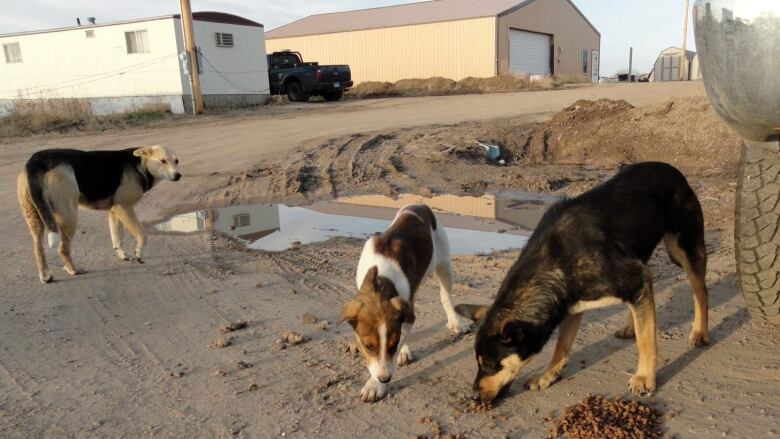Battle underway to control stray dog population in First Nations communities
Stricter bylaws, educational workshops, and sterilization campaigns are being employed

It's not everyday that a hockey rink is turned into an operating room.
That's what happened on a First Nations reserve 12 hours north ofMontreal, over a four-daystretch last month, where a team ofveterinarians set up shop.
They spayed or neutered about 250 dogs as part of an effort tocontrol the growing stray population in Opitciwan, Que.
- Fort Chip dog cull prompts howls from animal rescue groups
- Manitoba girl, 10, mauled to death by dogs in Lac Brochet
- Vist CBC Aboriginal for more top stories
It's one of dozens of such campaigns that take place each yearacross Canada's north, where wild dogs have long been a problem inremote communities, raising a host of health and safety concerns.
In the span of just over a month earlier this year, a 10-year-oldgirl and seven-year-old girl were mauled to death by dogs inseparate incidents in Manitoba.
New initiatives across country
New initiatives including stricter bylaws, educational workshops,and sterilization campaigns are being employed to get the problemunder control. Funding and resources, though, are often scarce.
"The overall goal is to control the stray population to makesure that there's less unwanted and abandoned litters," said Ewa Demianowicz, a manager with Humane Society International who waspart of the group that travelled to Opitciwan at the reserve'srequest.
"When you get there, there's an overpopulation problem andthere's also a welfare problem. We see a lot of injured animals or animals that are obviously sick or have a wound, and there's noveterinary clinic anywhere nearby."
Dogs have historically played a key role in the lives of First Nations communities, often relied upon for hunting and
protection. But today many are struggling, on a limited budget, to copewith overpopulation and strays.
Culling, which was previously seen as a quick way to reduce anout-of-control stray-dog population, has become increasingly taboo.
A Manitoba petition against the practice last year gained supportacross the country. It called for more federal funding to assist inspay-and-neuter programs.
Some communities, like Rama Mnjikaning First Nation, 150kilometres north of Toronto, have taken a different approach. It hasseen positive results from putting tougher rules in place.
The reserve's bylaw supervisor Al Sawyer said when he firststarted as an animal control program in 1996, there were bigproblems. Stronger regulations were necessary to make sure residentsand visitors to the community were safe, he said.
"You can't have dogs running around if you're going to havepeople coming to your establishments running at large," he said.
Tougher laws not enough
But tougher rules aren't always sufficient to deal with theproblem on reserves in more remote, northern communities, wherethere are often more dogs than residents and little access toveterinary care.
In the end our goal is to have models, so that if you wantcreate a new bylaw or education program or spay-neuter program, wecan help with that.-Dr. JasmineDhillon
Dr. Jasmine Dhillon, a veterinarian and PhD candidate at theUniversity of Saskatchewan, is involved in a new project aimed atcoming up with solutions on a case-by-case basis. She meets withcommunity members, including elders and the tribal council.
"In the end our goal is to have models, so that if you wantcreate a new bylaw or education program or spay-neuter program, wecan help with that," she said.
Dhillon said studies show some communities average upwards ofmore than two dogs per household.
For the project in northern Quebec, HSI partnered with the Quebecorganization Chiots Nordiques (Northern Puppies).They set up a similar clinic last year for dogs and cats inWemotaci, Que., a six-hour drive north from Montreal.
Demianowicz said it's been difficult to keep up with demand,especially given the costs.
"It involves a lot of finances, to be able to bring a team upthere and set up a clinic," she said."These communities often don't have the necessary resources to have these groups coming in."












_(720p).jpg)


 OFFICIAL HD MUSIC VIDEO.jpg)
.jpg)



























































































